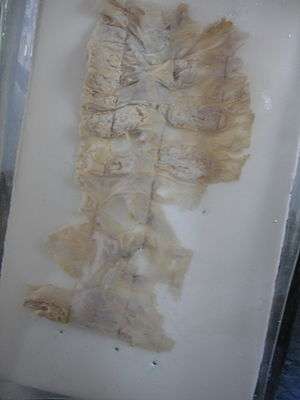Protozoan infection
| Protozoan infection | |
|---|---|
 | |
| Amoebic ulcer of the intestine caused by E. histolytica | |
| Classification and external resources | |
| DiseasesDB | 28851 |
| eMedicine | ped/1914 |
| MeSH | D011528 |
Protozoan infections are parasitic diseases caused by organisms formerly classified in the Kingdom Protozoa.[1] They include organisms classified in Amoebozoa, Excavata, and Chromalveolata.
Examples include Entamoeba histolytica, Plasmodium (some of which cause malaria), and Giardia lamblia.[2] Trypanosoma brucei, transmitted by the tsetse fly and the cause of African sleeping sickness, is another example.[3]
The species traditionally collectively termed "protozoa" are not closely related to each other, and have only superficial similarities (eukaryotic, unicellular, motile, though with exceptions.) The terms "protozoa" (and protist) are usually discouraged in the modern biosciences. However, this terminology is still encountered in medicine. This is partially because of the conservative character of medical classification, and partially due to the necessity of making identifications of organisms based upon appearances and not upon DNA.
Protozoan infections in animals may be caused by organisms in the sub-class Coccidia (disease: Coccidiosis) and species in the genus Besnoitia (disease: Besnoitiosis).
Treatment
They are treated with antiprotozoal agents.[1] Recent papers have also proposed the use of viruses to treat infections caused by protozoa.[4][5]
References
- 1 2 Protozoan Infections at the US National Library of Medicine Medical Subject Headings (MeSH)
- ↑ "Intestinal and Luminal Protozoa".
- ↑ "Sleeping Sickness".
- ↑ Keen, E. C. (2013). "Beyond phage therapy: Virotherapy of protozoal diseases". Future Microbiology. 8 (7): 821–823. doi:10.2217/FMB.13.48.
- ↑ Hyman, P.; Atterbury, R.; Barrow, P. (2013). "Fleas and smaller fleas: Virotherapy for parasite infections". Trends in Microbiology. 21 (5): 215–220. doi:10.1016/j.tim.2013.02.006. PMID 23540830.